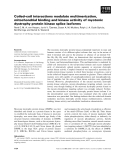
Internal control activities
-
After completing this chapter you should be able to: Define fraud and internal control, identify the principles of internal control activities, explain the applications of internal control principles to cash receipts, describe the operation of a petty cash fund,...and other contents.
 67p
67p  yenhinguyen0504
yenhinguyen0504
 06-04-2017
06-04-2017
 44
44
 5
5
 Download
Download
-
The myotonic dystrophy protein kinase polypeptide repertoire in mice and humans consists of six different splice isoforms that vary in the nature of their C-terminal tails and in the presence or absence of an internal Val– Ser–Gly–Gly–Gly motif. Here, we demonstrate that myotonic dystrophy protein kinase isoforms exist in high-molecular-weight complexes controlled by homo- and heteromultimerization.
 13p
13p  inspiron33
inspiron33
 26-03-2013
26-03-2013
 39
39
 5
5
 Download
Download
-
Altered protease activity is considered important for tumour invasion and metastasis, processes in which the cysteine proteases cathepsin B and L are involved. Their natural inhibitor cystatin C is a secreted protein, suggesting that it functions to control extracellular protease activity.
 12p
12p  galaxyss3
galaxyss3
 07-03-2013
07-03-2013
 45
45
 6
6
 Download
Download
-
The project builds on recommendations on delivery of biocontrol options to Vietnam identified by CABI and UNEP (Jenkins and Vos, 2000. Delivery of Biocontrol Technologies to IPM Farmers: Vietnam. UNEP/CABI Critical Issues Case Studies. CAB International/UNEP publication). The activities will consist of a workshop on biopesticide selection and identification, biopesticide production and product quality control, and on application and integration into farming systems.
 8p
8p  tam_xuan
tam_xuan
 02-03-2012
02-03-2012
 72
72
 4
4
 Download
Download
CHỦ ĐỀ BẠN MUỐN TÌM
















